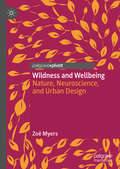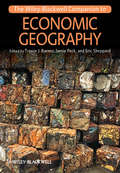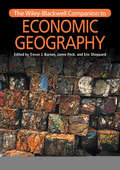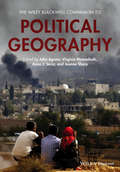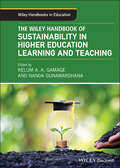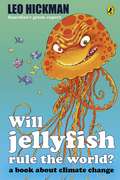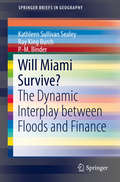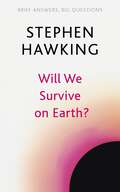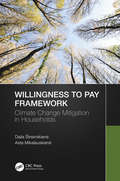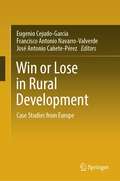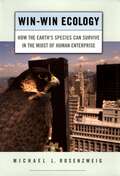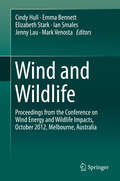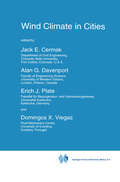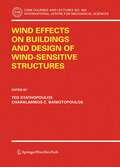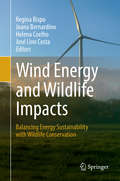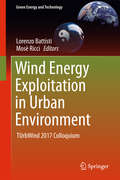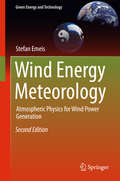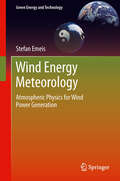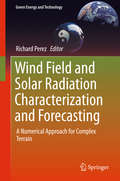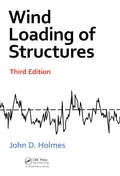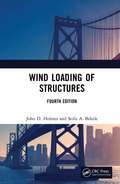- Table View
- List View
Wildness and Wellbeing: Nature, Neuroscience, and Urban Design
by Zoë MyersWildness and Wellbeing explores the dynamic relationships between urban nature and mental health, offering practical strategies for urban design. Mental health is a leading global issue and our urban environments can contribute to conditions such as depression and anxiety. Presenting the latest research, this book explores how neuroscience can offer new perspectives on the crucial role everyday multisensory interactions with nature can have on our mental wellbeing. These insights can help us (un)design our streets, neighbourhoods and cities, allowing nature to be integrated back into our cities. Wildness and Wellbeing is for anyone interested in the connections between urban ecology, health, environmental science, planning, and urban design, helping to create biodiverse cities for mental health.
The Wiley-Blackwell Companion to Economic Geography (Wiley Blackwell Companions to Geography #21)
by Trevor J. Barnes Jamie Peck Eric SheppardThe Wiley-Blackwell Companion to Economic Geography presents students and researchers with a comprehensive overview of the field, put together by a prestigious editorial team, with contributions from an international cast of prominent scholars. Offers a fully revised, expanded, and up-to-date overview, following the successful and highly regarded Companion to Economic Geography published by Blackwell a decade earlier, providing a comprehensive assessment of the field Takes a prospective as well as retrospective look at the field, reviewing recent developments, recurrent challenges, and emerging agendas Incorporates diverse perspectives (in terms of specialty, demography and geography) of up and coming scholars, going beyond a focus on Anglo-American research Encourages authors and researchers to engage with and contextualize their situated perspectives Explores areas of overlap, dialogues, and (potential) engagement between economic geography and cognate disciplines
The Wiley-Blackwell Companion to Economic Geography (Wiley Blackwell Companions to Geography #20)
by Trevor J. Barnes Jamie Peck Eric SheppardThe Wiley-Blackwell Companion to Economic Geography presents students and researchers with a comprehensive overview of the field, put together by a prestigious editorial team, with contributions from an international cast of prominent scholars. Offers a fully revised, expanded, and up-to-date overview, following the successful and highly regarded Companion to Economic Geography published by Blackwell a decade earlier, providing a comprehensive assessment of the field Takes a prospective as well as retrospective look at the field, reviewing recent developments, recurrent challenges, and emerging agendas Incorporates diverse perspectives (in terms of specialty, demography and geography) of up and coming scholars, going beyond a focus on Anglo-American research Encourages authors and researchers to engage with and contextualize their situated perspectives Explores areas of overlap, dialogues, and (potential) engagement between economic geography and cognate disciplines
The Wiley Blackwell Companion to Political Geography (Wiley Blackwell Companions to Geography)
by John A. Agnew Virginie Mamadouh Anna Secor Joanne SharpThe Wiley Blackwell Companion to Political Geography aims to account for the intellectual and worldly developments that have taken place in and around political geography in the last 10 years. Bringing together established names in the field as well as new scholars, it highlights provocative theoretical and conceptual debates on political geography from a range of global perspectives. Discusses the latest developments and places increased emphasis on modes of thinking, contested key concepts, and on geopolitics, climate change and terrorism Explores the influence of the practice-based methods in geography and concepts including postcolonialism, feminist geographies, the notion of the Anthropocene, and new understandings of the role of non-human actors in networks of power Offers an accessible introduction to political geography for those in allied fields including political science, international relations, and sociology
The Wiley Blackwell Companion to Political Geography (Wiley Blackwell Companions to Geography)
by John Agnew Virginie Mamadouh Anna J. Secor Joanne SharpThe Wiley Blackwell Companion to Political Geography aims to account for the intellectual and worldly developments that have taken place in and around political geography in the last 10 years. Bringing together established names in the field as well as new scholars, it highlights provocative theoretical and conceptual debates on political geography from a range of global perspectives. Discusses the latest developments and places increased emphasis on modes of thinking, contested key concepts, and on geopolitics, climate change and terrorism Explores the influence of the practice-based methods in geography and concepts including postcolonialism, feminist geographies, the notion of the Anthropocene, and new understandings of the role of non-human actors in networks of power Offers an accessible introduction to political geography for those in allied fields including political science, international relations, and sociology
The Wiley Handbook of Sustainability in Higher Education Learning and Teaching (Wiley Handbooks in Education)
by Kelum A. A. Gamage Nanda GunawardhanaA comprehensive resource for higher education professionals interested in sustainability pedagogy In The Wiley Handbook of Sustainability in Higher Education Learning and Teaching, a team of distinguished researchers delivers an insightful reference for higher education professionals seeking to embed sustainability in learning and teaching. The book offers a way for higher education institutions to implement sustainability goals in their curricula and provides comprehensive guidance to educators, researchers and practitioners. The authors discuss recent developments in technological innovations, best practices, lessons learned, current challenges, and reflections in the area of sustainability teaching in higher education. They also examine the impact of the COVID-19 pandemic on sustainability education. With contributors from a variety of disciplines, including engineering, medicine, urban design, business, environmental science, and social science, the book considers the embedding of sustainability in regenerative learning ecologies, living laboratories, and transgressive forms of learning. It also includes: A thorough introduction to activist learning for sustainability and outcome-based education towards achieving sustainable goals in higher education Comprehensive explorations of factors that hinder the implementation of sustainability initiatives in higher education institutions Practical discussions of developing stakeholder agency in higher education sustainability initiatives In-depth examinations of global trends and country-specific initiatives in sustainability teaching Perfect for education developers seeking to incorporate sustainability, The Wiley Handbook of Sustainability in Higher Education Learning and Teaching is also ideal for academics, researchers, policymakers, and accreditation personnel working in the area of sustainability.
The Wiley Handbook of Sustainability in Higher Education Learning and Teaching (Wiley Handbooks in Education)
by Kelum A. A. Gamage Nanda GunawardhanaA comprehensive resource for higher education professionals interested in sustainability pedagogy In The Wiley Handbook of Sustainability in Higher Education Learning and Teaching, a team of distinguished researchers delivers an insightful reference for higher education professionals seeking to embed sustainability in learning and teaching. The book offers a way for higher education institutions to implement sustainability goals in their curricula and provides comprehensive guidance to educators, researchers and practitioners. The authors discuss recent developments in technological innovations, best practices, lessons learned, current challenges, and reflections in the area of sustainability teaching in higher education. They also examine the impact of the COVID-19 pandemic on sustainability education. With contributors from a variety of disciplines, including engineering, medicine, urban design, business, environmental science, and social science, the book considers the embedding of sustainability in regenerative learning ecologies, living laboratories, and transgressive forms of learning. It also includes: A thorough introduction to activist learning for sustainability and outcome-based education towards achieving sustainable goals in higher education Comprehensive explorations of factors that hinder the implementation of sustainability initiatives in higher education institutions Practical discussions of developing stakeholder agency in higher education sustainability initiatives In-depth examinations of global trends and country-specific initiatives in sustainability teaching Perfect for education developers seeking to incorporate sustainability, The Wiley Handbook of Sustainability in Higher Education Learning and Teaching is also ideal for academics, researchers, policymakers, and accreditation personnel working in the area of sustainability.
Will Jellyfish Rule the World?: A Book About Climate Change
by Leo HickmanFrom what makes Earth so special, to how scientists know for sure our climate is changing, why it's a big deal for everyone and what we can all do right now to make a difference, green expert Leo Hickman is ready to answer all your questions.Will Jellyfish Rule the World? breaks down the causes and effects of climate change in a fresh, fun and easy-to-follow format. Packed with practical everyday things we can all do right now to make a difference, Will Jellyfish Rule the World? is a comprehensive, easy-to-use eco-handbook for budding classroom environmentalists everywhere.
Will Miami Survive?: The Dynamic Interplay between Floods and Finance (SpringerBriefs in Geography)
by Kathleen Sullivan Sealey Ray King Burch P. M. BinderThis SpringerBrief uses a complexity perspective to integrate risk, finance, and ecological issues in Miami, USA. It focuses on how the modern financial system, particularly the mortgage market, perceives and manages the risk of climate change. Authors Kathleen Sealey, Ray King Burch and P.-M. Binder offer the case study of South Florida to illustrate how landscapes can be either re-purposed to function ecologically when residents relocate or rebuilt to reduce the threat of future flooding, the tools needed to make these decisions, and how financial systems view and influence them. While the need to integrate financial markets into coastal (and environmental) management is increasingly recognized, the difficulty of this task is made greater by the speed of financial innovation and the obscurity and complexity of its practices. This book will discuss the innovative Southeast Florida Regional Climate Compact, and the success of public-private partnerships in planning and adapting to sea level rise, but also the broad disconnect with the cash-and-credit-driven real estate market of South Florida. The book presents an interdisciplinary approach to the understanding of the coupled human (including finance) and natural systems in coastal cities, thus breaking new ground in the approach towards sustainability research and education. The final chapter introduces the social component of resilience which include pre-disaster outreach with and the potential for decision theory to help people understand and manage risk.
Will We Survive on Earth? (Brief Answers, Big Questions)
by Stephen Hawking'Be brave, be curious, be determined, overcome the odds. It can be done'Will we survive on Earth?Should we colonise space?Throughout his extraordinary career, Stephen Hawking expanded our understanding of the universe and unravelled some of its greatest mysteries. In Will We Survive on Earth? the world-famous cosmologist and bestselling author of A Brief History of Time turns his attention to one of the most urgent issues for humankind and explores our options for survival.'Effortlessly instructive, absorbing and witty' GuardianBrief Answers, Big Questions: this stunning paperback series offers electrifying essays from one of the greatest minds of our age, taken from the original text of the No. 1 bestselling Brief Answers to the Big Questions.
Willingness to Pay Framework: Climate Change Mitigation in Households
by Dalia Štreimikienė Asta MikalauskienėThis book aims to develop a framework for the assessment of population ‘preferences in climate change mitigation policies by applying a Willingness to Pay (WTP) approach and presents the results from several case studies in Lithuania on renewable energy generation and renovation in different households. These analyses of climate change mitigation policies and measures, based on the assessment of their effectiveness, provide recommendations for developing innovative measures in other countries. Since public preferences are variable, climate change mitigation policies can change these preferences and allow to form new ones. Features: Analyses social benefits of climate change mitigation measures and their integration methods based on assessment of public preferences. Presents several practical case studies on energy needs where the Willingness to Pay framework was applied. Discusses climate change mitigation barriers in energy sector and the effectiveness of climate change mitigation policies to overcome them. Provides a novel approach for climate change mitigation policies development in households. Includes useful information for evaluating and planning policies related to renewable energy investment. This book is a useful reference for those in the academic, research, and business communities, policy makers, graduate students, and professionals involved with climate change mitigation projects.
Willingness to Pay Framework: Climate Change Mitigation in Households
by Dalia Štreimikienė Asta MikalauskienėThis book aims to develop a framework for the assessment of population ‘preferences in climate change mitigation policies by applying a Willingness to Pay (WTP) approach and presents the results from several case studies in Lithuania on renewable energy generation and renovation in different households. These analyses of climate change mitigation policies and measures, based on the assessment of their effectiveness, provide recommendations for developing innovative measures in other countries. Since public preferences are variable, climate change mitigation policies can change these preferences and allow to form new ones. Features: Analyses social benefits of climate change mitigation measures and their integration methods based on assessment of public preferences. Presents several practical case studies on energy needs where the Willingness to Pay framework was applied. Discusses climate change mitigation barriers in energy sector and the effectiveness of climate change mitigation policies to overcome them. Provides a novel approach for climate change mitigation policies development in households. Includes useful information for evaluating and planning policies related to renewable energy investment. This book is a useful reference for those in the academic, research, and business communities, policy makers, graduate students, and professionals involved with climate change mitigation projects.
Win or Lose in Rural Development: Case Studies from Europe
by Eugenio Cejudo-García Francisco Antonio Navarro-Valverde José Antonio Cañete-PérezThe aims of this book are: systematization and theorization of these projects; clarify and deepen the social and territorial effects of these initiatives; in-depth study of the causes that lead to the generation of successful projects in rural development; and abound in the reasons that lead specific projects to be failed in the access to LEADER support and be finally not implemented. This process of systematization and theorization would contribute to improving the decision-making in rural development, concretely the practice of these policies and initiatives. The book shows the problems, results and best practices that cause the rural development in different areas along with Europe. The multidisciplinary and international character of the authors in the analysis of rural development will enrich the publication and facilitate the different and critical reflections on the contributions, errors and meaning of these rural development practices.
Win-Win Ecology: How the Earth's Species Can Survive in the Midst of Human Enterprise
by Michael L. RosenzweigAs humanity presses down inexorably on the natural world, people debate the extent to which we can save the Earth's millions of different species without sacrificing human economic welfare. But is this argument wise? Must the human and natural worlds be adversaries? In this book, ecologist Michael Rosenzweig finds that ecological science actually rejects such polarization. Instead it suggests that, to be successful, conservation must discover how we can blend a rich natural world into the world of economic activity. This revolutionary, common ground between development and conservation is called reconciliation ecology: creating and maintaining species-friendly habitats in the very places where people live, work, or play. The book offers many inspiring examples of the good results already achieved. The Nature Conservancy, for instance, has a cooperative agreement with the Department of Defense, with more than 200 conservation projects taking place on more than 170 bases in 41 states. In places such as Elgin Air Force Base, the human uses-testing munitions, profitable timbering and recreation--continue, but populations of several threatened species on the base, such as the long-leaf pine and the red-cockaded woodpecker, have been greatly improved. The Safe Harbor strategy of the Fish & Wildlife Service encourages private landowners to improve their property for endangered species, thus overcoming the unintended negative aspects of the Endangered Species Act. And Golden Gate Park, which began as a system of sand dunes, has become, through human effort, a world of ponds and shrubs, waterfowl and trees. Rosenzweig shows that reconciliation ecology is the missing tool of conservation, the practical, scientifically based approach that, when added to the rest, will solve the problem of preserving Earth's species.
Wind and Wildlife: Proceedings from the Conference on Wind Energy and Wildlife Impacts, October 2012, Melbourne, Australia
by Cindy Hull Emma Bennett Elizabeth Stark Ian Smales Jenny Lau Mark VenostaThis book gathers papers presented and discussions held at the Conference on Wind Energy and Wildlife Impacts in Melbourne, Australia on 9th October 2012. The purpose of the conference was to bring together researchers, industry, consultants, regulators and Non-Government Organizations to share the results of studies into wind farm and wildlife investigations in Australia and New Zealand. The aim was to further networking and communication between these groups. The conference discussed key issues and areas for future investigation, with the intention of developing consistencies in research and management. Like the Conference, the book showcases current research and management in the field of wind farms and wildlife in Australia and New Zealand; establishes consistencies in research and management; and highlights areas in need of further examination. The papers in these Proceedings are presented in two session topics. The first covers “Investigations and assessment of new wind farms” and the second, “Monitoring, mitigation and offsets.”The Proceedings then summarize the panel discussions held at the end of the conference. The themes include improving pre- and post-construction survey design; identifying key knowledge gaps and research priorities; uncertainties and errors in data sets and analysis; creating opportunities to share knowledge; and assessing cumulative impacts across multiple sites.
Wind Climate in Cities (NATO Science Series E: #277)
by Jack E. Cermak Alan G. Davenport Erich J. Plate Domingos X. ViegasIf one surveys the development of wind engineering, one comes to the conclusion that the challenge of urban climatology is one of the most important remaining tasks for the wind engineers. But what distinguishes wind engineering in urban areas from conventional wind engineering? Principally, the fact that the effects studied are usually unique to a particular situation, requiring consideration of the surroundings of the buildings. In the past, modelling criteria have been developed that make it possible to solve environmental problems with great confidence, and studies validated the models: at least in a neutrally stratified atmosphere. The approach adopted in the book is that of applied fluid mechanics, since this forms the basis for the evaluation of the urban wind field. Variables for air quality or loads are problem specific, or even random, and methods for studying them are based on risk analysis, which is also presented. Criteria are developed for a systematic approach to urban wind engineering problems, including parameter studies. The five sections of the book are: Fundamentals of urban boundary layer and dispersion; Forces on complex structures in built-up areas; Air pollution in cities; Numerical solution techniques; and Posters. A subject index is included.
Wind Effects on Buildings and Design of Wind-Sensitive Structures (CISM International Centre for Mechanical Sciences #493)
by Ted Stathopoulos Charalambos C. BaniotopoulosWritten by seven internationally known experts, the articles in this book present the fundamentals and practical applications of contemporary wind engineering. It covers complex problems in wind-building interaction from the perspective of a structural designer, examining both experimental and computational approaches and their relative merits.
Wind Energy and Wildlife Impacts: Balancing Energy Sustainability with Wildlife Conservation
by Regina Bispo Joana Bernardino Helena Coelho José Lino CostaThis book provides a state-of-art overview of the significant advances in understanding the impacts of wind energy on wildlife. However, many challenges remain regarding planning and policy, assessment of direct and indirect effects on wildlife, methodological approaches, technology development, and mitigation strategies and their effectiveness. The book comprises a selection of the best contributions presented at the 4th Conference on Wind energy and Wildlife impacts, held in Estoril, Portugal, 2017. The contents promote the international cooperation among researchers, developers, regulators and stakeholders that have contributed to building knowledge on this topic.
Wind Energy Exploitation in Urban Environment: TUrbWind 2017 Colloquium (Green Energy and Technology)
by Lorenzo Battisti Mosè RicciThis book presents numerical and experimental research in the field of wind energy exploitation in urban environments. It comprises a selection of the best papers from the international colloquium “Research and Innovation on Wind Energy Exploitation in Urban Environment” (TUrbWind), held in Riva del Garda, Italy in June 2017. The book includes contributions from different research fields in urban wind resources, wind energy conversion systems, and urban integration, mainly focusing on the following topics: · concepts for urban and open landscape micro wind turbines, · integration of micro wind turbines in existing structures, · built-environment and high-turbulence sites’ impacts on urban wind turbines, · measuring and modeling wind resource in built environments, · rotor performance and wake features of micro wind turbines. It is a valuable resource for researchers and practitioners interested in the integration of wind energy systems and turbines in urban areas.
Wind Energy Meteorology: Atmospheric Physics for Wind Power Generation (Green Energy and Technology)
by Stefan EmeisThis book offers an introduction to the meteorological boundary conditions for power generation from wind – both onshore and offshore, and provides meteorological information for the planning and running of this important renewable energy source. It includes the derivation of wind laws and wind-profile descriptions, especially those above the logarithmic surface layer, and discusses winds over complex terrains and nocturnal low-level jets. This updated and expanded second edition features new chapters devoted to the efficiency of large wind parks and their wakes and to offshore wind energy.
Wind Energy Meteorology: Atmospheric Physics for Wind Power Generation (Green Energy and Technology)
by Stefan EmeisThis book is intended to give an introduction into the meteorological boundary conditions for power generation from the wind, onshore and offshore. It is to provide reliable meteorological information for the planning and running of this important kind of renewable energy. This includes the derivation of wind laws and wind profile descriptions, especially those above the logarithmic surface layer. Winds over complex terrain and nocturnal low-level jets are considered as well. A special chapter is devoted to the efficiency of large wind parks and their wakes.
Wind Field and Solar Radiation Characterization and Forecasting: A Numerical Approach for Complex Terrain (Green Energy and Technology)
by Richard PerezIn addition to describing core concepts and principles, this book reveals professional methodologies and tools used by national agencies and private corporations to predict sites’ potential for wind and solar power generation. Each chapter focuses on a different issue, showing readers the corresponding methodology, as well as examples of how to apply the techniques described. These techniques are explained with step-by-step guides that demonstrate how environmental variables in complex terrains can be characterized and forecasted.The authors present an adaptive finite element mass-consistent model, which computes a diagnostic wind field in the three-dimensional area of interest using observed wind data from measurement stations – data which is then interpolated using a physical model of the wind field in the boundary layer. An ensemble method is presented based on the perturbation of the numerical weather prediction models’ results. The book goes on to explain solar radiation characterization and forecasting. Solar radiation and electrical power generation temporal and spatial variability are discussed and modelled. Different statistical methods are presented in order to improve solar radiation forecasting using ground measurement, numerical weather predictions (NWPs) and satellite-derived data. This book is focused on both probabilistic and point forecast explaining different models and methodologies to improve the forecasting. The results obtained from various simulations around the world are presented in tables. Finally, the book explains a possible methodology to develop a Solar Map taking into account solar radiation, terrain surface conditions and cast shadows.As such, the book provides an overview of the concepts, principles and practices involved in the treatment of environmental variables related to solar radiation or wind fields, especially when complex terrains are involved, offering useful resources for students and researchers alike. It also equips professionals with the methodologies and tools needed to construct environmental variable maps and conduct forecasting for solar radiation and wind fields.
Wind Loading of Structures
by John D. HolmesA Definitive Up-to-Date Reference Wind forces from various types of extreme wind events continue to generate ever-increasing damage to buildings and other structures. Wind Loading of Structures, Third Edition fills an important gap as an information source for practicing and academic engineers alike, explaining the principles of wind loads on structures, including the relevant aspects of meteorology, bluff-body aerodynamics, probability and statistics, and structural dynamics. Written in Line with International Standards Among the unique features of the book are its broad view of the major international codes and standards, and information on the extreme wind climates of a large number of countries of the world. It is directed towards practicing (particularly structural) engineers, and academics and graduate students. The main changes from the earlier editions are: Discussion of potential global warming effects on extreme events More discussion of tornados and tornado-generated damage A rational approach to gust durations for structural design Expanded considerations of wind-induced fatigue damage Consideration of aeolian vibrations of suspended transmission lines Expansion of the sections on the cross-wind response of tall slender structures Simplified approaches to wind loads on "porous" industrial, mining, and oil/gas structures A more general discussion of formats in wind codes and standards Not dedicated to a specific code or standard, Wind Loading of Structures, Third Edition highlights the general format and procedures related to all major codes and standards, addresses structures of various types, and presents you with topics not typically covered in traditional texts such as internal pressures, fatigue damage by wind forces, and equivalent static wind load distributions.
Wind Loading of Structures
by John D. Holmes Seifu BekeleWind forces from extreme wind events are the dominant loading for many parts of the world, exacerbated by climate change and the continued construction of tall buildings and structures. This authoritative source, for practising and academic structural engineers and graduate students, ties the principles of wind loads on structures to the relevant aspects of meteorology, bluff-body aerodynamics, probability and statistics, and structural dynamics. This new edition covers: Climate change effects on extreme winds – particularly those from tropical cyclones, hurricanes, and typhoons Modelling of potential wind vulnerability and damage Developments in extreme value probability analysis of extreme windspeeds and directions Explanation of the difference between ‘return period’ and ‘average recurrence interval’, as well as ‘bootstrapping’ techniques for deriving confidence limits Wind over water, and profiles and turbulence in non-synoptic winds An expanded chapter on internal pressures produced by wind for various opening and permeability scenarios Aerodynamic shaping of high- and low-rise buildings Recent developments in five major wind codes and standards A new chapter on computational fluid dynamics (CFD), as applied to wind engineering A greatly expanded appendix providing basic information on extreme wind climates for over 140 countries and territories. Additional examples for many chapters in the book
Wind Loading of Structures
by John D. Holmes Seifu BekeleWind forces from extreme wind events are the dominant loading for many parts of the world, exacerbated by climate change and the continued construction of tall buildings and structures. This authoritative source, for practising and academic structural engineers and graduate students, ties the principles of wind loads on structures to the relevant aspects of meteorology, bluff-body aerodynamics, probability and statistics, and structural dynamics. This new edition covers: Climate change effects on extreme winds – particularly those from tropical cyclones, hurricanes, and typhoons Modelling of potential wind vulnerability and damage Developments in extreme value probability analysis of extreme windspeeds and directions Explanation of the difference between ‘return period’ and ‘average recurrence interval’, as well as ‘bootstrapping’ techniques for deriving confidence limits Wind over water, and profiles and turbulence in non-synoptic winds An expanded chapter on internal pressures produced by wind for various opening and permeability scenarios Aerodynamic shaping of high- and low-rise buildings Recent developments in five major wind codes and standards A new chapter on computational fluid dynamics (CFD), as applied to wind engineering A greatly expanded appendix providing basic information on extreme wind climates for over 140 countries and territories. Additional examples for many chapters in the book
